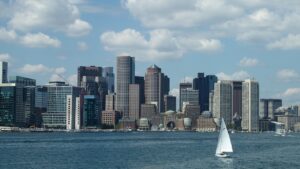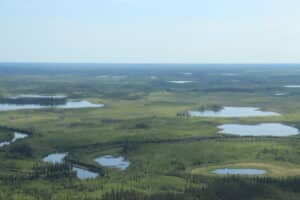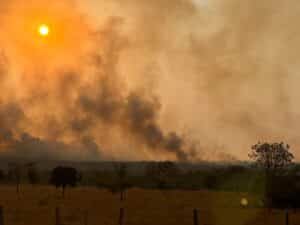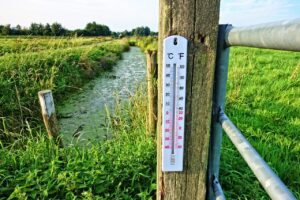Could a big hurricane whack New England? ‘More of a question of when than if.’

When Hurricane Helene blasted through western North Carolina in late September, devastating a region normally immune to severe damage from hurricanes, it woke up a wide swath of the country to a hard fact: We’re not as safe as we think.
That’s true in New England, too.
The nature of hurricanes has shifted as the planet warms due to climate change, with bigger, wetter, and stronger storms — something we’ve now seen happen twice in rapid succession, with Hurricane Milton following Helene.
Read more on The Boston Globe.
Nowhere in America is safe from climate-fueled storms and fires

Forecasters had warned for days that Hurricane Helene was likely to cause widespread devastation. But when the powerful storm struck Florida and barreled through the eastern US last week, killing more than 180 people and taking whole communities offline, it still managed to come as a shock.
Florida’s Big Bend, where Helene made landfall, previously went decades without a hurricane strike. In the past year or so, it has now seen three. The western half of North Carolina, once held up as a haven from the worst impacts of climate change, has been paralyzed by floods.
Destructive hurricanes like Helene highlight that catastrophic impacts from storms can extend far inland
Inland communities will increasingly need to prepare for impacts from storms.

Destructive hurricanes like Helene are a stark reminder that significant and devastating impacts from many major storms are not relegated to coastal cities and communities — inland regions often face catastrophic impacts too, experts are warning.
The Category 4 hurricane made landfall on Florida’s Big Bend region Thursday night before tracking north, leaving a wake of destruction over 400 miles in the days the followed.
Is methane release from the Arctic unstoppable?
Global warming has already caused the Arctic to release more climate-warming methane—but exactly how much will depend closely on the actions we take to halt climate change.

Under the Arctic ice lies an extremely carbon-rich environment. Over thousands of years, plants in the Arctic have absorbed carbon dioxide (CO2) from the air to grow, before being buried under snow and ice during the winter, becoming part of the soil. If this perennially frozen ground thaws—as it is now, as a result of climate change—ancient plants are uncovered, alongside plant-eating microbes that break them down.
This releases two main climate-warming greenhouse gases: CO2, and even more potent methane.
Continue reading on Climate Portal.
Thousands of fires are burning in the drought-wracked Amazon

Much of Brazil is burning as tens of thousands of fires rage around the country, half of them in the Amazon rainforest. Exacerbated by a severe drought, the fires threaten one of the world’s most crucial ecosystems and are consuming the Amazon’s vast stores of carbon, sending more of the damaging greenhouse gas into the atmosphere.
2.4 million hectares (about 6 million acres) of forests, fields and pastures in the Amazon burned between June and August. There were more than 95,000 hot spots in the Amazon biome this year to Sept. 18, according to data from Brazil’s National Institute for Space Research, known as Inpe.
Historic rainfall inflicts chaotic floods across four continents

Severe rains bucketed down on central Europe, Africa, Shanghai and the US Carolinas this week, underscoring the extreme ways in which climate change is altering the weather.
Different meteorological phenomena are behind the series of storms, according to climate scientists, though they agree an underlying factor for the supercharged rainfall is global warming writ large. Research has shown that hotter air is capable of carrying more moisture and is more likely to cause intense precipitation.
Permafrost Pathways’ recommendations for urgent congressional action
Rising temperatures across the Circumpolar North are catalyzing more severe and intense environmental hazards in the US-Arctic region. Among the most dangerous trends is thawing permafrost, i.e., the loss of continuously frozen ground that underlies roughly 38% of land surface in Alaska. As permafrost thaws, it destabilizes critical infrastructure, destroying homes, schools, roads, and public utilities. Compounding effects of flooding, erosion, and thaw-induced ground collapse pose imminent environmental threats for at least 144 Alaska Native communities. Permafrost thaw also holds global significance, as it contains an estimated 1.4 trillion tons of carbon, or roughly twice as much carbon as is currently in the Earth’s atmosphere. Without aggressive, near-term climate mitigation, resulting greenhouse gas emissions (carbon dioxide and methane) from permafrost thaw and increasingly intense wildfires in the Arctic-boreal region may be on par with the highest-emitting countries. Fortunately, Permafrost Pathways understands these challenges and is working to leverage the best available science to avoid worst climate scenarios and to advance equitable adaptation responses to permafrost thaw.
The policy recommendations linked to the right are informed by active collaboration with Arctic communities, scientific experts, youth leaders, and innovators in both the public and private sectors. They are intended to align with current US federal policies, including those named in the 2022 National Strategy for the Arctic Region and its Implementation Plan (2023), which identified Permafrost Pathways as a key partner in US government efforts to advance a more resilient and secure Arctic region.
Learn more on Permafrost Pathways’ website.
Hottest summer on record could lead to the warmest year ever measured

Summer 2024 sweltered to Earth’s hottest on record, making it even more likely that this year will end up as the warmest humanity has measured, European climate service Copernicus reported Friday.
And if this sounds familiar, that’s because the records the globe shattered were set just last year as human-caused climate change, with a temporary boost from an El Nino, keeps dialing up temperatures and extreme weather, scientists said.
Read more on Associated Press News.




